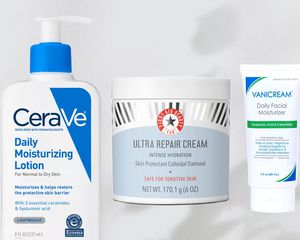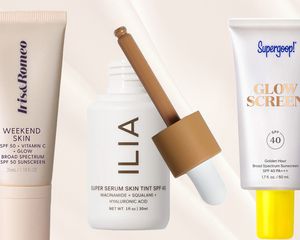:max_bytes(150000):strip_icc()/sunprotection-6eb21800dabb4808b96ee875db625b30.jpg)
Ohlamour Studio / Stocksy
At this point we’re all aware of the importance of slathering on sunscreen regularly to protect our skin from the sun’s harmful rays. It’s key to preventing a slew of serious health issues, especially skin cancer. But, some sunscreen ingredients, particularly those found in chemical sunscreens, can trigger their own set of health problems.
Once one of the most popular ingredients for formulating sunscreen, oxybenzone has been relegated to the sidelines after earning a bad rep. Over the last few years, oxybenzone has been believed to be potentially bad for the oceans, particularly coral reefs, and has been banned in many places as a result. However, a 2021 study revealed the ingredient is not causing significant harm to coral reefs.
Aside from its controversial environmental history, oxybenzone is possibly bad for your body. “Oxybenzone is absorbed into the skin and we know now into the bloodstream,” says Corey L. Hartman, MD, founder of Skin Wellness Dermatology in Birmingham, Alabama. While absorption into your skin doesn't automatically deem an ingredient unsafe, oxybenzone can cause irritation, disrupt hormone channels, and act as a disruptor of normal biological processes in the skin and in the body. Keep reading to find out everything you need to know about oxybenzone.
Meet the Expert
- Corey L. Hartman, MD, is the founder of Skin Wellness Dermatology in Birmingham, Alabama.
- Gary Goldenberg, MD, is board-certified dermatologist and founder of Goldenberg Dermatology in New York City.
Oxybenzone
Type of Ingredient: Organic compound.
Main Benefits: Protects from UVA damage and protects from UVB damage.
How Often Can You Use It: Sunscreen should be applied every two hours, or sooner after swimming or sweating.
Works Well With: In general, antioxidants have been shown to boost the efficacy of sunscreen and deliver other skin perks as well.
Don't Use With: There aren’t any specific ingredients you should avoid using with oxybenzone.
What Is Oxybenzone?
Oxybenzone is an organic compound that is a derivative of benzophenone. Most commonly used in chemical sunscreens, it can also be found in nail polish, fragrances, hairspray, and cosmetics, since it’s used as a photostabilizer, as well as in plastics and toys. “Oxybenzone is a chemical sunscreen ingredient that's an organic UV filter,” Hartman explains. “It is one of the more common ingredients included in chemical sunscreens. Chemical sunscreens absorb into the skin; they don't sit on top like a physical sunscreen does. They form a chemical reaction that stops the effect of the UV rays on inducing erythema and causing DNA damage that can lead to skin cancer, but it has to take place through a chemical reaction, and that's why they're called chemical sunscreens.” Chemical sunscreens, including oxybenzone, work by absorbing UV radiation, and during the chemical reaction, the sun’s UV rays are converted into heat and released from the skin.
Benefits of Oxybenzone for Skin
Like every other sunscreen ingredient, oxybenzone’s mission is to protect skin from the sun. While oxybenzone does have its benefits, there are other sunscreen ingredients that also have those perks without any potential side effects. With that in mind, these are the benefits of oxybenzone:
- Sun protection. “Oxybenzone is able to absorb harmful UVA and UVB rays,” says Gary Goldenberg, MD, board-certified dermatologist and founder of Goldenberg Dermatology in New York City. “This prevents UV from reaching the skin cells, reducing the risk of skin damage.”
- Ease of application and blendability. “Newer formulations are easier to apply and wear, leaving less of a white residue on the skin,” Goldenberg says. In the past, chemical sunscreens were recommended for those with darker skin tones, since they were less likely to leave a white cast and were easier to blend in. However, Hartman notes that mineral sunscreens have vastly improved in this department and many are now less chalky and easier to blend.
Who Should Use It
Anyone looking for sun protection can use oxybenzone to filter the sun's rays. However, there are other sunscreen ingredients that safeguard skin without potential side effects.
Side Effects of Oxybenzone
Oxybenzone has become such a controversial ingredient that many dermatologists, including Hartman, have advised their patients to avoid it completely. "It is banned in many places,” Goldenberg says. "There are other alternatives, and many brands have completely stopped using it."
Numerous studies have researched the dangers of oxybenzone. “There have been at least two studies that have been published that have shown that it's absorbed into the bloodstream,” Hartman says. "Although they have established that there is absorption into the bloodstream, we haven't quite figured out what that means, and what are the ramifications of that? We don't quite know. We're starting to get an idea, but we haven't quite worked that out completely."
A 2020 study showed that having an elevated systemic level of oxybenzone has no adverse effect on male and female fertility, female reproductive hormone level, adiposity, fetal growth, child’s neurodevelopment and sexual maturation. However, the effect of oxybenzone levels on thyroid hormone, testosterone level, kidney function and pubertal timing has been reported and further research must be conducted to confirm a link.
Another potential side effect of oxybenzone is dermatitis. "I have seen some patients develop an allergic reaction to oxybenzone," Goldenberg says. "This usually manifests by skin redness and irritation after use." Though some people may experience adverse reactions to oxybenzone, research has found that sunscreen products formulated with 1–6% oxybenzone do not possess a significant sensitization or irritation potential for the general public.
Hartman also says a key problem is that most chemical sunscreen products don't contain only one chemical—they usually have at least four, sometimes as many as five or six. "So, if you have contact dermatitis, you don't even know which ingredient it is that caused it, and then you really don't know what to avoid," Hartman says. "25% of all people are going to be allergic to chemical sunscreens; that's a pretty high number. I think that there are so many problems with a lot of the different chemical sunscreens."
How to Use It
Rain or shine, sunscreen should be applied every single day as the final step in your skincare routine. The same application rules go for oxybenzone sunscreens as with any other sunscreen formula. “I recommend applying sunscreen every morning after washing your face, over your daily moisturizer and before makeup application,” Goldenberg says. “Sunscreen should be applied 30 minutes before sun exposure and reapplied every two to three hours. Being safe and consistent with sunscreen application is the best thing you can do for your skin year-round.”
Mineral/Physical Sunscreens vs. Chemical Sunscreens
While chemical sunscreens absorb UV light, physical (aka mineral) sunscreens sit on top of the skin and work like a shield to reflect the sun’s rays. “I recommend physical sunscreens to everybody,” Hartman says. “Physical sunscreens in the past, especially for people with darker skin tones, haven't always been elegant or fun to wear. But there are some great products now that are transparent, that don't leave that white iridescent cast, and they're great products that anybody can use. With the advent of physical sunscreens that are elegant, I don't really see a role for chemical sunscreens at all, not to mention the fact that they also have more detrimental environmental effects. So, in my practice, and to my social media followers, I always recommend physical sunscreen.”

